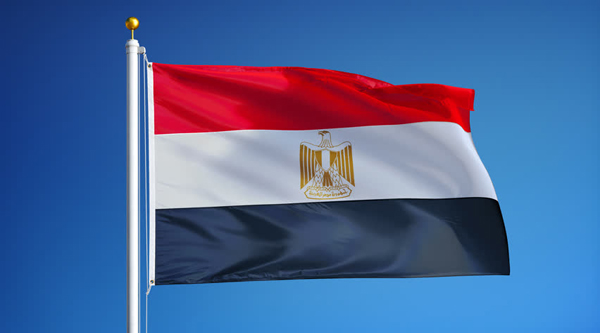Flag of Egypt : its history, meaning and development
4.8 / 5 36 ReviewsEgyptian Flag
Egyptian flag had many colours and forms through out its history. Let's find out how it appeared, what colours it was in the beginning and how it changed until reaching the modern one we see now.
The shape and the size of the Egyptian flags varied from the small ones that carried a simple slogan, to the big ones burdened with medals and slogans. The oldest shape of these flags that referred to the pharaoh was a flag used during the reign of Hatshepsut. The flag was a semi-circle inside a half fan (the full sun). Those flags were of attractive colours and fastened on a long wooden pole. During the reign of Akhnaton a piece of long cloth was added to the flag on the top of the pole and right under the fan. This piece of cloths consisted of 3 stripes – red, green and red. This flag was hoisted before the pharaoh during his military campaigns or religious ceremony. It was also engraved on some Egyptian temples. The shape of this fan kept representing the traditional image of the flag until the end of the ancient age and some minor changed had been introduced to it as well.
Beside the royal flag there were flags for all military divisions. Each carried a symbol and a ribbon of the god which was followed by the soldier of the division. There were also flags shaped like a sun boat or an Ancient Egyptian alphabet, or an animal: lion, falcon, gazelle, ostrich feather etc. In some cases flag consisted of more than one shape and military units had their own flags. Military ships had their own flags as well. King’s ship crew had also their own flag. This flag showed a sitting person with a royal crown on his head and the traditional fan (full sun). The rest of military ships carried flags on the front.
Flags developed a great deal in Egypt during the Middle Ages. The black Abbasidian flag was used for the entire Egyptian Army during the Abbasids, Tulunids and Ikshidids period. When the Fatimids emerged in Egypt in 909 AD, a green flag was used instead. That was done to distinguished the Fatimid reign from the previous reigns. They also called their military flags “Al Brood” and a house called “Dar al Brood” was set aside. The flag of the Fatimid Khaliph was distinguished from the rest of the flags by being set on a platform with a gold bowl and a crescent on the top. With the end of Fatimid era and emergence of Ayubids in Egypt in 1171 AD, who followed Soni faction of the Islamic religion, Abbasidian black flags came back to use. During Mmluks this black flag was used as well. Beside, each Mamluk leader had his own private flag with a reproduction of eagle, sword, lion and so on in the center of the flag, symbolizing this particular leader. Background of such flags was mainly white or red.
Mamluks era is famous for its military parades preceded by flag carriers. The head of the parade “Al Alam Dar” carried the flag of the big sultan while “Al Songk Dar” carried the flag of the nation. A group carried other similar flags was called “Al Sanagk”. A group called “Al Grawishia” carried some other flags with drawings of titles of the sultan (“Al Assab”). When Egypt was under Ottoman occupation in 1517 AD, the official flag of Egypt became the Ottoman red Turkish flag with a white crescent and the hexagonal star. This flag was in use until Mohammed Ali Pasha in 1805 AD came to power. In 1823 AD he adjusted a new private flag for Egypt. The flag was red with a white crescent in the middle that surrounded a white star. To distinguish it from the Turkish flag the star was a pentagon instead of a hexagon as on a Turkish flag. It remained that way until 1867 when Al Khedawy Ismaiel adopted a different flag as a primary step to achieve independence from Turkey. Inside each crescent was a pentagonal white star. There three crescents referred to the three regions that comprised the Egyptian nation at that time: Main Egypt, Upper Egypt and Sudan. When British occupied Egypt in 1882 AD, this flag was cancelled and Ottoman red flag with a crescent and a white star was back in use.
The situation remained so until the outbreak of the World War I in 1914 when Turkey’s mandate over Egypt was abrogated and the British protection over Egypt was imposed. The red flag with 3 crescents and 3 stars regained and remained the flag of the Egyptian Sultanate until December 10, 1923 AD, when a royal order was issued stated the use of a new flag for the Egyptian Kingdom. The flag became green with a crescent and 3 stars. This flag was in use until the revolution in 1952. And in 1958 when the Egyptian-Syrian union was established the flag was changed to have three colours: red, white and black. Two stars were replaced in the middle of the white part which symbolized the 2 countries of the union – Egypt and Syria. Later the stars were replaced by an eagle, and now this is the flag we have in Egypt.
The name of Egyptian flag changed during times as follows: during Umayyad and Abbasid reigns it was called “Al Lwaa”, “Bnd” during Fatimids, and "Sanagk" during Mamluk and Turkish time.
